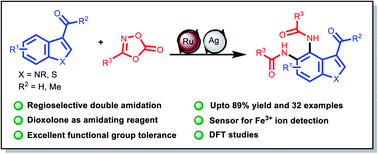Ruthenium(ii)-catalyzed regioselective direct C4- and C5-diamidation of indoles and mechanistic studies†
Abstract
A ruthenium(II)-catalyzed regioselective direct diamidation of 3-carbonylindoles at the C4- and C5-positions using various dioxazolones is described. This novel protocol allows for the effective installation of two amide groups on the benzene ring in indole. A remarkably broad substrate scope, excellent functional group tolerance, and mild reaction conditions are notable features of this protocol. Further explorations reveal that benzo[b]thiophene-3-carboxaldehyde is a viable substrate and affords its corresponding diamidation products. The diamido indoles are further converted into various functionalized products and used as sensors for metal ion detection. Density functional theory studies are also conducted to propose a reaction mechanism and provide a detailed understanding of the regioselectivity observed in the reaction.



 Please wait while we load your content...
Please wait while we load your content...